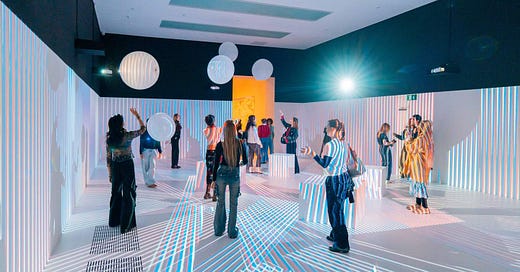⚫️ Electric encounters: art before the internet
Tate Modern's latest exhibition, "Electric Dreams: Art and Technology Before the Internet," is a captivating journey through the 20th century's artistic romance with technology. Running until June 1, 2025, the show features over 150 works by more than 70 international artists who explored the intersection of art and science from the 1950s to the dawn of the internet.
Visitors are greeted by a dreamscape of machines, movement, and captivating installations that play with perception. Highlights include Pol Bury's motorized bristle sculpture, François Morellet's dynamic corridor of blue and red squares, and Vera Spencer's collage of colored punched cards. The exhibition also showcases early experiments with home computers and video synthesizers, offering a rare glimpse into vintage tech art in action.
One of the standout pieces is Atsuko Tanaka's "Electric Dress," a wearable sculpture made of hand-painted industrial bulbs and incandescent tubes, created in 1956. The dress, which was uncomfortably hot and potentially dangerous, was inspired by neon advertising signs Tanaka saw while waiting for a train in Osaka.
The exhibition also features works by artists like Brion Gysin, who pioneered cut-ups with William Burroughs in the 1950s, and Liliane Lijn, whose miniature theatre with flickering lights creates a mesmerizing experience. These pieces, along with many others, highlight the innovative ways artists engaged with emerging technologies to expand cultural horizons and imagine the future we now live in.
From the birth of op art to the dawn of the internet age, artists found new ways to engage the senses and play with our perception. Electric Dreams celebrates the early innovators of optical, kinetic, programmed and digital art, who pioneered a new era of immersive sensory installations and automatically-generated works.
This major exhibition brings together groundbreaking works by a wide range of international artists who engaged with science, technology and material innovation. Experience the psychedelic environments they created in the 1950s and 60s, built using mathematical principles, motorised components and new industrial processes. See how radical artists embraced the birth of digital technology in the 1970s and 1980s, experimenting with machine-made art and early home computing systems.
"Electric Dreams" is a must-see for anyone interested in the history of art and technology, offering a poignant and often beautiful vision of human creativity engaging with machines.
More info:
Electric Dreams: Art and Technology Before the Internet (Exhibition Guide)





